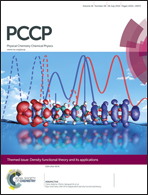C60 molecules grown on a Si-supported nanoporous supramolecular network: a DFT study
Abstract
C60 fullerene assemblies on surfaces have attracted considerable attention because of their remarkable electronic properties. Now because of the competition between the molecules–substrate and the molecule–molecule interactions, an ordered C60 array is rather difficult to obtain on silicon surfaces. Here we present density functional theory simulations on C60 molecules deposited on a TBB (1,3,5-tri(1′-bromophenyl)benzene) monolayer lying on the Si(111)–boron surface (denoted SiB). The C60 molecules are located in the nanopores formed by the TBB network. Adsorption energy calculations show that the SiB surface governs the C60 vertical position, whereas the TBB network imposes the C60 lateral position, and stabilizes the molecule as well. The low charge density between the C60 and the SiB substrate on one hand, and on the other hand between the C60 and the TBB molecules, indicates that no covalent bond is formed between the C60 and its environment. However, according to charge density differences, a drastic charge reorganisation takes place between the Si adatoms and the C60 molecule, but also between the C60 and the surrounding TBB molecules. Finally, calculations show that a C60 array sandwiched between two TBB molecular layers is stable, which opens up the way to the growth of 3D supramolecular networks.


 Please wait while we load your content...
Please wait while we load your content...